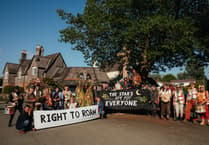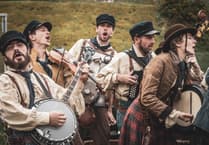IT is a modest grave. In place fewer than 40 years, subsidence has already caused the headstone to tilt. Lichen has taken hold and the words, shallowly etched, are not easy to discern: Siegfried Loraine Sassoon, 1886-1967, RIP.
Just that. No mention of the soldier whose courage on the Western Front in the Great War won him a Military Cross. No mention of the poet whose work seethed with contempt for the ?scarlet Majors? who ?speed glum heroes up the line to death?.
Just the name and the dates.
Sassoon lies in the churchyard of St Andrew?s in the village of Mells, near Frome, amid a row of graves that face the Somerset countryside.
Yet this village church and the graves around it are a touching testimony to England?s literary, artistic, and political history.
St Andrew?s, described by the authority on church architecture, Nicholas Pevsner, as having an arrangement of buttresses and pinnacles ?as ingenious as any in Somerset?, stands at the end of a row of golden stone cottages in the peaceful village.
The church is believed to date from the 15th century when £3 was bequeathed for the building of a tower. Further bequests in that century paid for the building of the vestry.
And those modest beginnings helped establish a church that later attracted work by leading artists.
On one wall is a memorial to Raymond Asquith, son of the Liberal Prime Minister. The lettering is by the famous font designer Eric Gill, who created the typeface that was used on railway signs. A bronze wreath above it was the work of Sir Edwin Lutyens, the architect who designed Castle Drogo.
Raymond Asquith had married Katherine Horner, heir to the local estate ? legend has it that the family name and its ?plum? estate gave rise to the nursery rhyme, Little Jack Horner. Quaint thought, but it is a myth.
On one side of the church, in a small chapel, stands an equestrian statue, sculpted by the distinguished equestrian artist Sir Alfred Munnings. It is of a young officer, Edward Horner, who died in France in 1917. The statue stands on a plinth designed by Lutyens and reminiscent of the sculptor?s abstract yet powerfully eloquent Cenotaph in London?s Whitehall.
But what brings home the sense of loss of a young man is not the great work of art, but a simple wooden cross attached to one end of the plinth. Originally marking his grave in France, it bears the basic details of the life and death of one of thousands scythed down in the grim wilderness that was the Western Front.
Siegfried Sassoon ? he owed his Christian name to his mother?s love of Wagner?s operas ? came from a wealthy family and was educated at Marlborough and Clare College, Cambridge.
He enthusiastically enlisted two days before the Great War broke out, but the brutal reality of trench conflict led him publicly to question the conduct of the war.
Only the intervention of his friend and fellow poet and officer, Robert Graves, who said Sassoon was in need of medical treatment, saved him from severe punishment.
He was sent to a hospital in Scotland to be treated for shell shock and while there met and encouraged a younger poet whose name would be forever linked with the Great War: Wilfred Owen.
The angry and satirical tone of Sassoon?s war poems prompted a future poet, the young Charles Causley, to join the Royal Navy in the Second World War. Causley first read Sassoon in the 1930s and was deterred from service in khaki by ths poet?s grimly realistic descriptions of life in the trenches.
Sassoon lived most of his life in Wiltshire and regularly met two other great literary figures: Thomas Hardy and T E Lawrence, of Lawrence of Arabia fame. At Lawrence?s funeral in Dorset in 1935, Sassoon, incensed by the intrusive presence of the press, struck a photographer whose camera smashed to the ground. Small beer for a man who had been in the thick of the greatest conflict the world had known.
Sassoon wanted to be buried in Mells churchyard so that he would be close to the grave of a man he greatly admired, Ronald Knox, the priest, scholar, preacher and writer, who died in 1957.
The churchyard contains the graves of many Catholics ? Sassoon converted to the faith late in life and, sadly, in vain, wanted to be remembered as a religious poet rather than a war poet.
His grave is near several whose family names are synonymous with 20th century social and political history, the Asquiths, and the Bonham Carters ? the actress Helena Bonham Carter is a great-grand-daughter of the Liberal Prime Minister Herbert Asquith.
Further afield, by the churchyard?s edge, lies another grave that recalls a later conflict.
It is of a couple who died in the 1960s, and bears a touching inscription signed by six names: ?We thank them for their kindness and care during World War Two. With love from the evacuees.?
The six must have worshipped in St Andrew?s, attended the Sunday school, celebrated festivals of the changing seasons.
Each of the six, like the many other names in the churchyard, modestly or magnificently, made their mark upon a community that houses a remarkable church.



